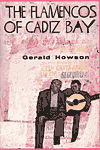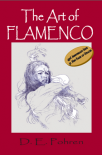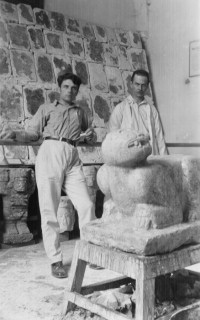BOOKS ON FLAMENCO
The Flamencos of Cadiz Bay
This is a biographical memoir by the English writer, Gerald Howson. Originally written prior to 1965, and relating to Howson’s sojourn in Spain between 1954-7; ostensibly as an ESL teacher, the book was re-published in a second edition in 1993 with commentary by the author reflecting on his own writing nearly thirty years prior and the way that life in Spain had radically changed. You have to keep reminding yourself that this is not a novel, and that the author is relating stories of his own experience. Captivating from beginning to end, Howson’s Spain is at once romantic and beautiful and yet brutal and austere. The characters that fill the pages of his storytelling are nearly all larger than life, but never does one get the sense that his descriptions of either people or events are merely inflated rhetoric.
I truly recommend you tracking down a copy of this book. A word to the wise: read the appendices whilst you’re reading the book, rather than at the end. It would, frankly have been better for the book to have had footnotes. Aside from this small quibble, I learned more about the form and structure in Flamenco from reading this book than I did from books that were meant to explain these concepts to me – and the book doesn’t even set out to do that!
The Art of Flamenco
D. E. Pohren’s The Art of Flamenco (revised Ed.) is the bible. I’d suggest reading this after The Flamencos of Cadiz Bay – the reason being, that the in-depth explanation of the various cantes can be a bit overwhelming. It is, nonetheless, regarded as the bible on the subject.
Don’t get me wrong, it’s not a dry, academic read at all.
If nothing else, Mr. Pohren’s passion for his subject matter comes through clear and strong.
Pohren also has two other related books on Flamenco: a book about Paco de Lucia and his family and Lives and Legends of Flamenco: a biographical history.
BOOKS ON MÉXICO
Below is a list of books consulted in writing the musicalised version of The Mapmaker’s Opera by Béa Gonzalez.
Incidents of Travel in the Yucatan
Stephens, John Lloyd, Catherwood, Frederick. Incidents of Travel in Yucatan, Vols. I and II. New York: Cosimo.
In this classic work, originally published in 1847, John Lloyd Stevens records the second of his historic trips through the Yucatan peninsula. Stevens and his companion, English artist Frederick Catherwood, almost single-handedly brought the news of the pre-conquest Mayan civilization to readers the world over, touching off a century and a half of archeological discovery. The book has a detailed description of the town layout of Mérida about 60 years before the period of the novel (and the Musical) – close enough! Disclaimer: it’s a dense read, but the illustrations are great.
An Archaeological Guide to Mexico’s Yucatan Peninsula
Kelly, Joyce. An Archaeological Guide to Mexico’s Yucatan Peninsula. Norman and London: University of Oklahoma Press, 1993.
The Yucatan peninsula is covered with at least 150 known sites, of which only a few of the ruins have been uncovered. The book is amply enriched with illustrations, diagrams and photographs to help you understand the significance of the Yucatan’s often, inscrutable buildings and structures of the Mayan people.
Barbarous Mexico
Turner, John Kenneth. Barbarous Mexico. Texas: University of Texas Press. Texas Pan American Series, 1969. Béa gave me her copy that she had used in the research of writing The Mapmaker’s Opera. Only for those of you really committed to reading about the historical and social landscape of the period – it’s a stomach churner. Not for children.
Red Tiger: Adventures in Yucatán and México
Russell, Phillips. Illustrated by Leon Underwood. Red Tiger: Adventures in Yucatán and México<. New York: Brentanos. Originally published in 1929, Russell and Underwood followed the route taken by Stephens and Catherwood in 1839. (Incidents of Travel in Central America, Chiapas and Yucatán). This is a charming book with a much easier narrative than the sometime dense prose in the earlier work by Stephens. It is, at the very least, interesting to read the difference in perception of change in the Yucatán region between Stephens’ 1840s exploration of the region and Phillips and Underwood’s footsteps over the same terrain 70 years later.
Time Among The Maya: Travels in Belize, Guatemala, and Mexico
Wright, Ronald. Time Among The Maya. New York: Weidenfeld & Nicolson. This 1989 volume is an excellent read. Traveling through Central America’s jungles and mountains, Ronald Wright explores the ancient roots of the Maya, their recent troubles, and prospects for survival. Embracing history, anthropology, politics, and literature, the narrative is a riveting journey through past magnificence and the study of an enduring civilization with much to teach the present.
The Wind That Swept Mexico
Text by Brenner, Anita. Assembled by Leighton, George R. The Wind That Swept Mexico. Texas: University of Texas Press. Texas Pan American Series. Originally published in 1943, was the first book to present a broad account of that revolution in its several different phases. In concise but moving words and in memorable photographs, this classic sweeps the reader along from the false peace and plenty of the Díaz era through the doomed administration of Madero, the chaotic years of Villa and Zapata, Carranza and Obregón, to the peaceful social revolution of Cárdenas and Mexico’s entry into World War II.
Revolutionary México: The Coming and Process of the Mexican Revolution
Hart, John Mason. Revolutionary México: The Coming and Process of the Mexican Revolution. California: University of California Press. Regarded widely as the best concise account of Mexican History. This acclaimed reinterpretation of the Mexican Revolution, based on new evidence obtained in Mexican and American archives and on the historical literature of recent years, was made available in a tenth anniversary edition, complete with a new Preface by the author, in 1997. It’s worth the effort.
Fabulous Spain
Reynolds, James. Fabulous Spain. New York: G. P. Putnam’s Sons. A somewhat quaint, but nonetheless highly enjoyable, 1953 volume of travel throughout Spain. I really like this book more than perhaps is suggested in this brief entry.










